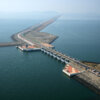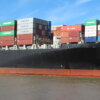Types of materials to be dredged include a wide variety of sediments, soils, clays, silt, rock, sand and debris.
The primary categories are:
- peat and organic soils,
- cobbles,
- clays,
- boulders,
- silts,
- broken rock,
- sands,
- rock and gravel, and
- cemented soils.
Characteristics of dredged material
Within each of these major categories are ranges of physical characteristics –particle size, particle nature and plasticity. The type of material and the physical characteristics determine which dredging equipment will be the most effective, what types of production rates to expect, what may be the potential end uses or placement of the material, and the handling of the material, such as bulking and formation of clay balls. The chemical and biological characteristics of the material are also relevant.
Extensive studies are necessary to determine what equipment to use and whether materials are suitable for a specific destination such as beach nourishment or land reclamation or must be treated or disposed of elsewhere.
Environmental aspects
Most importantly, the type of material has a significant bearing on the environmental effects of the dredging and disposal process. Clean materials can easily be excavated and placed and used for a variety of purposes.
Contaminated sediments may require differing degrees of treatment and careful consideration as to placement and reuse. Many will be usable, but some sediments may need to be confined and are not reusable.
Hazards
Dredging may also encounter hazards that can be dangerous to crews and equipment. These include unexploded ordnance, pipelines and cables, a build-up of hydrogen sulphide, large boulders, debris and wrecks. These may have to be removed or handled in very specific ways.
TAGS
related
Videos
Presentation: ‘Sand as a Resource’ by Jan Fordeyn (Jan De Nul) − Director Project Development & Conceptual Design

In our day to day lives most of us are not aware of how many industries rely on sand as a part of their working process. The amount of sand consumed has dramatically increased over the last few years and this can be largely contributed to the world wide construction boom. How is this going to affect us in the future?









